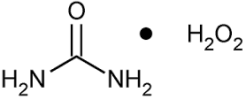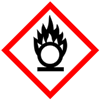Carbamide Peroxide or Urea Hydrogen Peroxide SDS MSDS of Manufacturers |
| Mubychem Limited of USA & India is a pioneer manufacturers suppliers exporters & importers of chemicals including Hydraulic fracturing stimulation & oil well production chemicals, Pharmaceutical excipients, Fragrance & flavor chemicals. Muby Chem Ltd has several manufacturing facilities and toll manufacturers across the globe. We have offices warehouses and representatives in Houston & Midland Texas and Chicago Illinois USA. |
| Our suppliers have accreditations like FDA - GMP-GLP approval, ISO-9001, ISO-22000 HACCP, Kosher & Halal Certification. We offer Commercial Pure Pharmacopoeia Analytical Reagent & Food Grade of Chemicals and do Toll Manufacturing for Oil well drilling fracking fracturing and others. |
Specifications of Carbamide Peroxide Manufacturers
Carbamide Peroxide
Commercial Pure & USP Grade

Carbamide Peroxide or Urea Hydrogen Peroxide SDS MSDS Sheet, Material Safety Data Sheet
1. Product Identification
CAS No.: 124-43-6
Molecular Weight: 94.07
Chemical Formula: CH6N2O3
2. Hazards Identification
GHS, Globally Harmonized System Classification in accordance with 29 CFR 1910
Classification according to Regulation (EC) No 1272/2008
Oxidizing liquids; Oxidizing solids Category 3
Skin corrosion/irritation Category 1A, B, C
Labeling according Regulation (EC) No 1272/2008
GHS Label Elements  Oxidizing Solid |
|
Signal Word: Danger
Hazard Statements:
H272: May intensify fire; oxidizer.
H314: Causes severe skin burns and eye damage.
Precautionary Statements:
P210: Keep away from heat/sparks/open flames/hot surfaces. - No smoking.
P220: Keep/Store away from clothing/other combustible materials.
P221: Take any precaution to avoid mixing with combustibles.
P260: Do not breathe dust/fume/gas/mist/vapors/spray.
P264: Wash … thoroughly after handling.
P280: Wear protective gloves/protective clothing/eye protection/face protection.
P301+330+331: IF SWALLOWED: Rinse mouth. Do NOT induce vomiting.
P303+361+353: IF ON SKIN (or hair): Remove/Take off immediately all contaminated clothing. Rinse skin with water/shower.
P304+340: IF INHALED: Remove victim to fresh air and keep at rest in a position comfortable for breathing. P305+P351+P338: IF IN EYES: Rinse cautiously with water for several minutes. Remove contact lenses, if present and easy to do. Continue rinsing.
P362: Take off contaminated clothing and wash before reuse.
P337+P313 If eye irritation persists: Get medical advice/ attention.
P405: Store locked up.
P501: Dispose of contents/container to authorized agents only.
3. Composition/Information on Ingredients
Ingredient: Carbamide Peroxide
CAS No.: 124-43-6
Percent: 97 - 100%
4. First Aid Measures
Always seek medical attention after first aid measures are provided.
Inhalation: Remove to fresh air. If not breathing, give artificial respiration. If breathing is difficult, give oxygen. Get medical attention.
Ingestion: Never give anything by mouth to an unconscious person. Get medical attention.
Skin Contact: Wipe off excess material from skin then immediately flush skin with plenty of water for at least 15 minutes. Remove contaminated clothing and shoes. Get medical attention. Wash clothing before reuse. Thoroughly clean shoes before reuse.
Eye Contact: Immediately flush eyes with plenty of water for at least 15 minutes, lifting lower and upper eyelids occasionally. Get medical attention immediately.
Note to Physician: Symptomatic and supportive treatment is recommended.
5. Fire Fighting Measures
Flammability of the Product: Non-flammable but it is an oxidizer.
Products of Combustion: It emits toxic oxides of nitrogen when heated to decomposition.
Fire: It is supporting fire as an oxidizer.
Explosion: Contact with oxidizable substances may cause explosion.
Fire Extinguishing Media: Use water spray, alcohol-resistant foam, dry chemical or carbon dioxide. Use means suitable for extinguishing surrounding fire.
Special Information: In the event of a fire, wear full protective clothing and NIOSH-approved self-contained breathing apparatus with full face piece operated in the pressure demand or other positive pressure mode. At high temperatures or when moistened under fire conditions, it may produce toxic or irritating fumes.
6. Accidental Release Measures
Small Spill: Avoid dust formation. Avoid breathing dust. Ensure adequate ventilation. Use appropriate tools to put the spilled solid in a convenient waste disposal container. Finish cleaning by spreading water on the contaminated surface and dispose of according to local and regional authority requirements.
Large Spill: Do not let the product enter drains. Use a shovel to put the material into a convenient waste disposal container. Finish cleaning by spreading water on the contaminated surface and allow evacuating through the sanitary system.
7. Handling and Storage
Do not breathe dust. Wear suitable protective clothing. In case of insufficient ventilation, wear suitable respiratory equipment.
Avoid contact with skin and eyes. Avoid formation of dust and aerosols. Wash hands thoroughly after handling. Provide appropriate exhaust ventilation at places where dust is formed. If you feel unwell, seek medical attention.
Keep in a tightly closed container, stored in a cold (2C), dry, ventilated area. Short term shipping may be at room temperature. Protect against physical damage or contact with combustible substances.
8. Exposure Controls/Personal Protection
Airborne Exposure Limits: None established.
Ventilation System: A system of local and/or general exhaust is recommended to keep employee exposures as low as possible. Local exhaust ventilation is generally preferred because it can control the emissions of the contaminant at its source, preventing dispersion of it into the general work area.
Personal Respirators (NIOSH Approved): For conditions of use where exposure to dust or mist is apparent and engineering controls are not feasible, a particulate respirator may be worn. For emergencies or instances where the exposure levels are not known, use a full-face positive-pressure, air-supplied respirator.
Skin Protection: Wear protective gloves and clean body-covering clothing.
Eye Protection: Use chemical safety goggles and/or full face shield where dusting or splashing of solutions is possible. Maintain eye wash fountain and quick-drench facilities in work area.
Other Control Measures: Maintain good housekeeping in work area. Dust deposits on floors and other surfaces may pick up moisture and cause the surfaces to become slippery and present safety hazards. Handle in accordance with good industrial hygiene and safety practice. Wash hands after handling.
9. Physical and Chemical Properties
Appearance: White crystals or powder or granules.
Odor: Slight.
Solubility: Soluble in water.
pH: Not available,
Density: 1.39 gm/cc.
Molecular Weight: 94.07
Chemical Formula: CH6N2O3
% Volatile by volume @ 21C (70F): 0
Melting Point: 80-90C (Decomposes)
Vapor Density (Air=1): No information found.
Vapor Pressure (mm Hg): No information found.
10. Stability and Reactivity
Stability: It is stable under recommended conditions of use and storage.
Hazardous Decomposition Products: It emits toxic oxides of nitrogen when heated to decomposition.
Hazardous Polymerization: Will not occur.
Incompatibilities: Organic substances, Metal powders and Reducing agents.
Conditions to Avoid: Incompatibles and heat.
11. Toxicological Information
Toxicity to Animals: LD50 Oral: >2000 mg/kg (Rat).
Carcinogenicity: No component of this product present at levels greater than or equal to 0.1% is identified as probable or confirmed human carcinogen by IARC, ACGIH, OSHA and NTP.
Mutagenic Effects: Not available.
Teratogenic Effects: Not available.
Developmental Toxicity: Not available.
12. Ecological Information
Environmental Fate: No information found.
Environmental Toxicity: The material is not considered as environmental hazard.
Results of PBT and vPvB assessment: This substance/mixture contains no components considered to be either persistent, bioaccumulative and toxic (PBT), or very persistent and very bioaccumulative (vPvB) at levels of 0.1% or higher.
13. Disposal Considerations
Whatever cannot be saved for recovery or recycling should be managed in an appropriate and approved waste disposal facility. Processing, use or contamination of this product may change the waste management options. State and local disposal regulations may differ from federal disposal regulations. Dispose of container and unused contents in accordance with federal, state and local requirements. Small amounts of this material may be suitable for sanitary sewer or trash disposal.
14. Transport Information
DOT (USA)
UN number: 1511 Class: 5.1 (8). Packing group: III
Proper shipping name: Urea hydrogen peroxide
Marine pollutant: No
Poison Inhalation Hazard: No
IMDG
UN number: 1511 Class: 5.1 (8). Packing group: III
Proper shipping name: Urea hydrogen peroxide
Marine pollutant: No
Poison Inhalation Hazard: No
IATA
UN number: 1511 Class: 5.1 (8). Packing group: III
Proper shipping name: Urea hydrogen peroxide
Marine pollutant: No
Poison Inhalation Hazard: No
15. Regulatory Information
USA:
Section 313: Not applicable.
SARA 311/312 Hazards: Acute Health Hazard, Chronic Health Hazard.
Section 16 - Additional Information
DISCLAIMER: The information and recommendations set forth herein (hereinafter "Information") are presented in good faith and believed correct as of the date hereof. It is compiled from various sources and it is not necessarily all inclusive nor fully adequate in every circumstance. In addition, these suggestions should not be confused with nor followed in violation of applicable laws, regulations, rules or insurance requirements applicable. This MSDS sheet is intended only as a guide to the appropriate precautionary handling of the material by a properly trained person using this product. Individuals receiving the information must exercise their independent judgment in determining its appropriateness for a particular purpose.
Carbamide Peroxide Manufacturers:
Muby Chem Ltd.
Toll manufacturing & Warehouse at Houston Beasley & Midland, Texas, USA
USA, Canada, Mexico Customers may e-mail: usa@mubygroup.com
Call 1-844-682-9243
Europe Africa Asia India Mumbai e-mail: info@mubygroup.com
Call +91-22-23774610


Suppliers Manufacturers Exporters Importers between USA Canada UAE Europe South Africa Tanzania Kenya Uganda Egypt Nigeria Turkey Mexico Brazil Argentina Chile Dubai China India etc.
Copyright and Usual Disclaimer is Applicable.
If you feed a dog with your hand, it will never bite you. That is the principal difference between a dog and a man.







